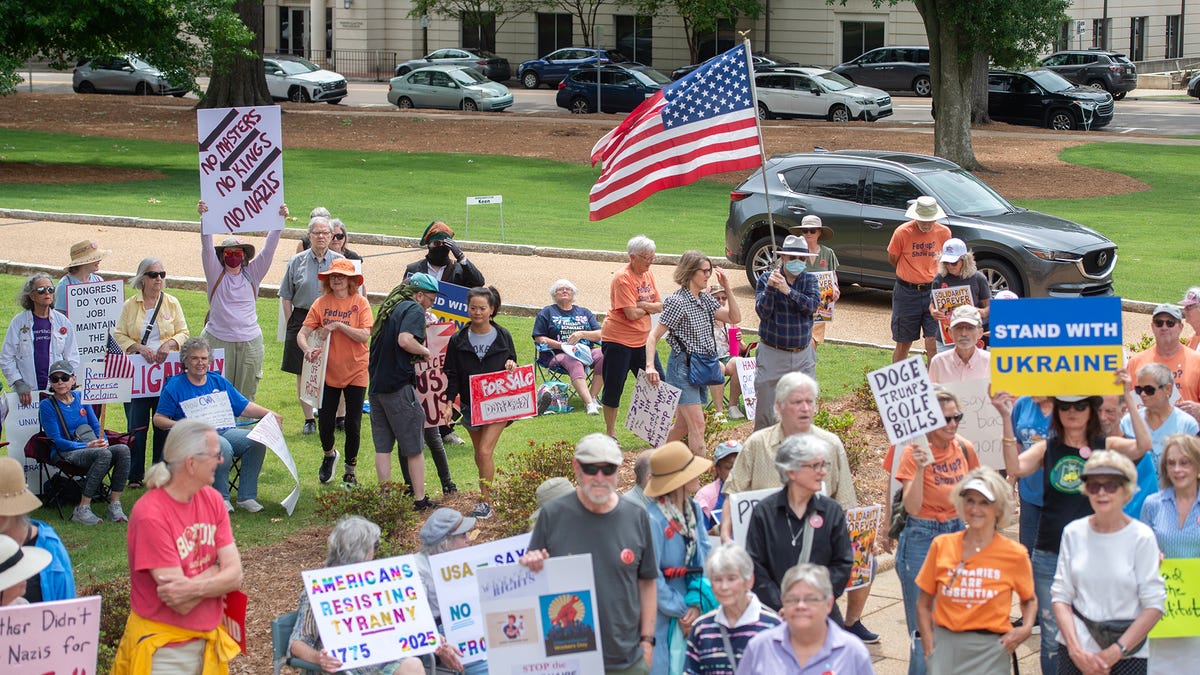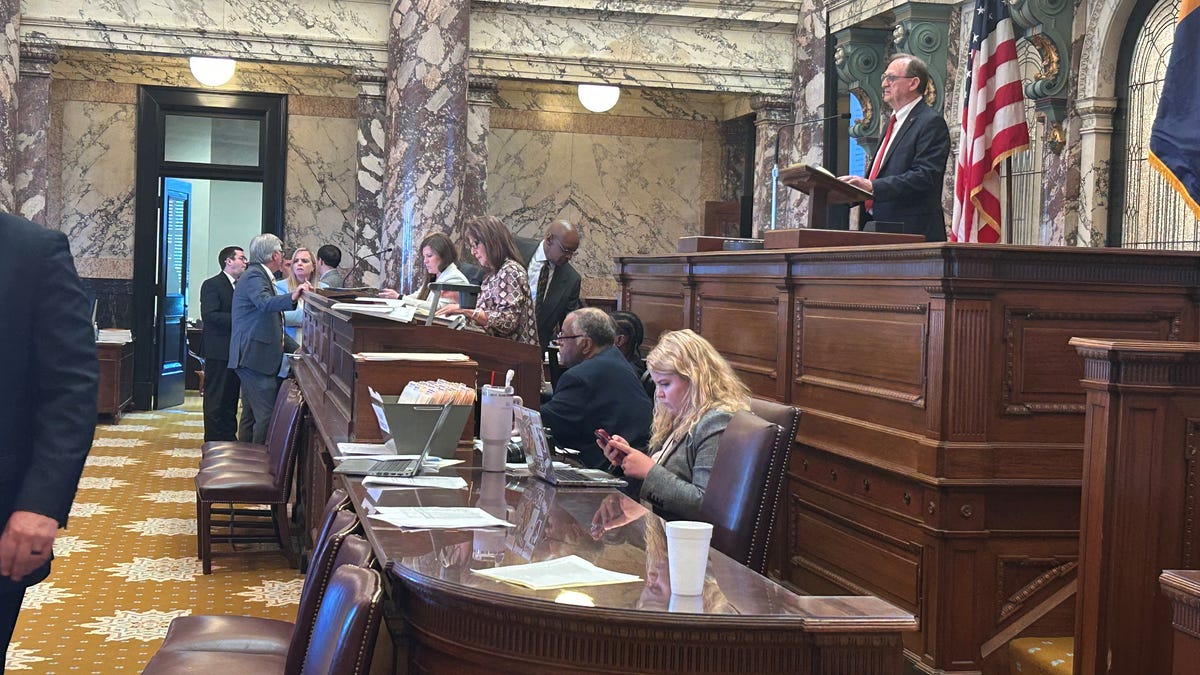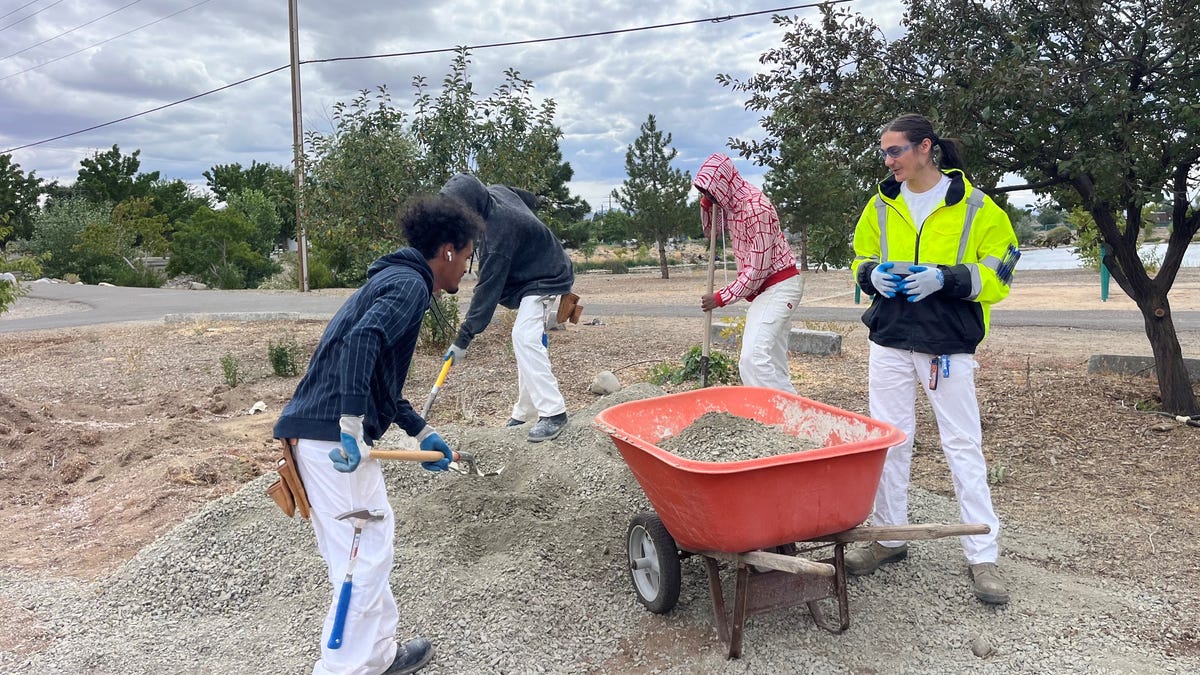Montana
Trump heads to Montana in a bid to oust Sen. Tester after failing to topple the Democrat in 2018

BOZEMAN, Mont. — With control of the Senate potentially at stake, Donald Trump is visiting Montana on Friday hoping to remedy some unfinished business from 2018, when he campaigned repeatedly in Big Sky Country in a failed bid to oust incumbent Democratic Sen. Jon Tester.
Tester has tried to convince voters he’s aligned with Trump on many issues, mirroring his successful strategy from six years ago. While that worked in a non-presidential election year, it faces a more critical test this fall with Tester’s opponent, former Navy SEAL Tim Sheehy, trying to link the three-term incumbent to Democratic presidential candidate Kamala Harris.
Harris has benefitted nationally from a burst of enthusiasm among core Democratic constituencies, who coalesced quickly around her after President Joe Biden withdrew from the campaign last month. She’s drawn big crowds in swing states, touring this week with Minnesota Gov. Tim Walz, her choice to be her vice presidential nominee.
Trump’s only rally this week, meanwhile, will be in a state he won by 16 percentage points four years ago rather than a November battleground. Facing new pressure in the race from a candidate with surging enthusiasm, Trump on Thursday called questions about his lack of swing state stops “stupid.”
“I don’t have to go there because I’m leading those states,” he said. “I’m going because I want to help senators and congressmen get elected.”
He will add on fundraising stops in Wyoming and Colorado.
Friday’s rally at Montana State University, which starts at 8 p.m. Mountain time, is expected to draw thousands of GOP supporters. Yet the former president’s bigger impact could be simply having his name above Sheehy’s on the ballot in November, said University of Montana political analyst Rob Saldin.
“There is a segment of the electorate that will turn out when Trump is on the ticket,” Saldin said. And that could benefit Sheehy, a Trump supporter and newcomer to politics who made a fortune off an aerial firefighting business.
Republicans have been on a roll in Montana for more than a decade and now hold every statewide office except for Tester’s.
Tester won each of his previous Senate contests by a narrow margin, casting himself as a plainspoken farmer who builds personal connections with people in Montana and is willing to break with his party on issues that matter to them. He’s also become a prolific fundraiser.
The race has drawn national attention with Democrats clinging to a razor-thin majority in the Senate and defending far more seats than the GOP this year. Tester is considered among the most vulnerable Democratic incumbents.
For him to win, large numbers of Trump supporters would have to vote a split ticket and get behind the Democratic senator.
Trump’s drive to oust Tester traces back to the lawmaker’s role in 2018 as chairman of the Senate Committee on Veterans’ Affairs. Tester revealed past misconduct by Trump’s personal physician, Ronny Jackson, that sank Jackson’s nomination to lead the Department of Veterans Affairs.
Then-President Trump took the matter personally and came to Montana four times to campaign for Republican Matt Rosendale, who was then the state auditor. Rosendale lost by 3 percentage points.
Ahead of Trump’s latest visit, Tester has sought to insulate himself against charges that he’s part of the Democratic establishment by rolling out the names of Republicans who support him, including former Montana Gov. Marc Racicot. His campaign highlighted more than 20 pieces of legislation, many dealing with veterans’ issues, that Tester sponsored and Trump signed.
Tester also was the sole Democratic delegate from Montana to withhold a vote backing Harris as the party’s presidential candidate in the wake of Biden’s withdrawal. And when the Democratic National Convention takes place later this month in Chicago, Tester will be back in Montana “farming and meeting face to face with Montanans,” campaign spokesperson Harry Childs said.
The last time Tester attended the Democratic National Convention was in 2008. That’s also the last time a Democratic presidential candidate came anywhere near winning Montana, with President Barack Obama losing by just over 2 percentage points.
Friday’s rally takes place in Gallatin County, which Tester has become increasingly reliant on over the course of his political career.
He lost the county in his first Senate race, in 2006, but his support has since grown. A substantial margin of victory in Gallatin in 2018 helped push him ahead of Rosendale.
Republican Don Seifert, a former Gallatin County commissioner, said he voted for Tester that year and plans to do so again this year.
Seifert backed Trump in 2016 and said he has continued to support other Republicans, including Montana Gov. Greg Gianforte and Sen. Steve Daines.
“Montanans tend to vote for the person over the party,” Seifert said. “For the state of Montana, Jon is that one that can do what we need.”
But Sheehy says Tester has lost touch with his home state and fallen into step with Democrats in Washington. The Republican alleged in a message this week to supporters that Tester was “responsible for the rise of Kamala Harris” because he served as chairman of the Democratic Senatorial Campaign Committee from 2015 to 2017, when she was elected to the Senate from California.
Tester has outraised Sheehy by more than three-to-one in campaign donations reported to the Federal Election Commission. However, outside groups supporting Sheehy have helped the Republican make up much of that gap, pouring tens of millions of dollars into the race as advertisements from the two sides saturate Montana’s airwaves.

Montana
Crews battling wildfire outside of Plains

PLAINS — Crews responded to a wildfire in Sanders County at 5:20 p.m. Saturday.
The Plains-Paradise Rural Fire District was called out to Locust Lane off Montana Highway 28 northeast of Plains for reports of smoke in the area.
The Montana Department of Natural Resources and Conservation also responded to the scene as well as Plains City Fire and Hot Springs Fire for mutual aid.
What is being called the Banana Lake Incident by the DNRC has burned three acres since being discovered on Saturday.
No further information is available at this time.
Montana
Montana Lottery Mega Millions, Lucky For Life results for May 30, 2025
The Montana Lottery offers multiple draw games for those aiming to win big. Here’s a look at May 30, 2025, results for each game:
Winning Mega Millions numbers from May 30 drawing
02-28-37-38-58, Mega Ball: 13
Check Mega Millions payouts and previous drawings here.
Winning Lucky For Life numbers from May 30 drawing
13-17-30-35-48, Lucky Ball: 09
Check Lucky For Life payouts and previous drawings here.
Winning Big Sky Bonus numbers from May 30 drawing
08-19-21-22, Bonus: 13
Check Big Sky Bonus payouts and previous drawings here.
Feeling lucky? Explore the latest lottery news & results
When are the Montana Lottery drawings held?
- Powerball: 8:59 p.m. MT on Monday, Wednesday, and Saturday.
- Mega Millions: 9 p.m. MT on Tuesday and Friday.
- Lucky For Life: 8:38 p.m. MT daily.
- Lotto America: 9 p.m. MT on Monday, Wednesday and Saturday.
- Big Sky Bonus: 7:30 p.m. MT daily.
- Powerball Double Play: 8:59 p.m. MT on Monday, Wednesday, and Saturday.
- Montana Cash: 8 p.m. MT on Wednesday and Saturday.
Missed a draw? Peek at the past week’s winning numbers.
Winning lottery numbers are sponsored by Jackpocket, the official digital lottery courier of the USA TODAY Network.
Where can you buy lottery tickets?
Tickets can be purchased in person at gas stations, convenience stores and grocery stores. Some airport terminals may also sell lottery tickets.
You can also order tickets online through Jackpocket, the official digital lottery courier of the USA TODAY Network, in these U.S. states and territories: Arizona, Arkansas, Colorado, Idaho, Maine, Massachusetts, Minnesota, Montana, Nebraska, New Hampshire, New Jersey, New York, Ohio, Oregon, Puerto Rico, Washington D.C., and West Virginia. The Jackpocket app allows you to pick your lottery game and numbers, place your order, see your ticket and collect your winnings all using your phone or home computer.
Jackpocket is the official digital lottery courier of the USA TODAY Network. Gannett may earn revenue for audience referrals to Jackpocket services. GAMBLING PROBLEM? CALL 1-800-GAMBLER, Call 877-8-HOPENY/text HOPENY (467369) (NY). 18+ (19+ in NE, 21+ in AZ). Physically present where Jackpocket operates. Jackpocket is not affiliated with any State Lottery. Eligibility Restrictions apply. Void where prohibited. Terms: jackpocket.com/tos.
This results page was generated automatically using information from TinBu and a template written and reviewed by a Great Falls Tribune editor. You can send feedback using this form.
Montana
Questions and answers about Montana’s new second-home tax

In an effort to lower property tax bills for homeowners and landlords who provide long-term rental housing, the state Legislature and Gov. Gianforte passed major tax relief legislation this year. As it’s implemented this year and next, the package will scale back taxes on most houses being used as primary residences while offsetting those cuts with higher taxes on most other residential properties starting in 2026.
As we cover the new tax policy, which the Montana Department of Revenue expects to boost second-home taxes by 68% on average, the MTFP newsroom is fielding many, many questions from readers. We’re compiling the most frequent ones — and the best answers we currently have — below.
We’ll update this story periodically as other questions roll into our inboxes and as officials release additional information on how the specifics of the new tax policy will work. As always, we’d love to hear comments and questions at news@montanafreepress.org.
Q: When will the second-home tax take effect?
Interim rates will lower taxes for many residential properties on the tax bills sent by county treasurers this fall. However, the second-home tax won’t be implemented until 2026 tax bills, when it will raise taxes on most residential properties that don’t qualify for a “homestead” exemption.
Proponents had initially wanted to make the second-home tax effective this year, but added provisions for an interim year after negotiations on it dragged into the final days of the legislative session, missing the February deadline Gianforte had initially said would be necessary for the revenue department to implement the full policy this year.
Q: Who is eligible for the lower residential homestead rates?
A: Two types of residential property owners: Homeowners who live in their homes at least seven months a year and landlords who rent homes out on long-term leases for at least seven months a year. Long-term means leases that last at least a month, like the leases used for resident rental housing but unlike the terms for Airbnb-style short-term rentals.
Q: Will there be more property tax rebates?
Yes. The Legislature also authorized a round of $400 rebates for homeowners, which will be available this year and apply against last year’s tax bill. Those follow the $675 rebates the Legislature authorized for homeowners in each of 2024 and 2023.
The new tax law requires the revenue department to mail a notice about the rebates to potentially eligible property owners by June 30. Eligible homeowners who meet the same seven-month occupancy standard that will be used for the eventual homestead exemption will be able to claim the rebate by applying between Aug. 15 and Oct. 1 this year.
Q: Do I need to apply to avoid paying the second-home tax?
Yes. When it takes full effect in 2026, the new law will assess higher taxes on any residential property that doesn’t qualify for the homestead exemption. Homeowners and landlords will need to apply to the revenue department for the exemption that will qualify them for lower rates.
Once homeowners are qualified for the homestead exemption, they will remain qualified until they sell the property, move elsewhere or apply for a homestead on a different residence. Landlords will need to periodically reapply to certify properties are still being used as long-term rentals.
Additionally, homeowners who qualify for a property tax rebate this year will be automatically qualified for the homestead exemption going forward.
Q: How do I apply?
As of May 2025, the revenue department hasn’t yet published the necessary forms, but homeowners and landlords will be able to apply either by mail or online. The new law specifies that the application deadline for 2026 tax bills will be March 1, 2026.
The applications will ask property owners to formally declare that they’re using a property as either a principal residence or long-term rental. If the department discovers a taxpayer has fraudulently claimed the benefit, the law specifies that they will have to pay a penalty of three times the amount saved and be subject to potential criminal prosecution under a state law that can n result in a $500 fine and a jail term of up to six months.
Eligible homeowners and landlords who fail to apply for the homestead rates initially may be able to receive refunds if they appeal successfully after receiving higher tax bills.
Q: I’ve heard there’s an exception for homes on agricultural land?
Yes. The tax package’s long-term rates place residential structures on agricultural land at their current levels regardless of whether they qualify as principal residences, an exemption intended to shield worker bunkhouses and other secondary residences in farm complexes from the second-home tax. That provision also means that second homes — including many high-value ones — located on qualified agricultural properties will be largely shielded from the second-home tax.
Separately from the second-home tax debate, revenue department officials and some lawmakers have expressed concern that it may be too easy to qualify undeserving properties for an agricultural status under current law, a process that currently requires reporting only $1,500 a year in agricultural income. A bill that would have tightened the qualification requirements for the agricultural designation, introduced separately from the property tax relief package, failed to pass the Legislature this year.
Q: What if I run an Airbnb out of part of my home? Will that keep me from qualifying for the homestead exemption?
You’ll probably be fine. The bill doesn’t explicitly address this situation, but the definition of “principal residence” included in the law focuses on whether a taxpayer owned and occupied a given residential property for at least seven months of the year. It also says you can’t claim more than one property as a principal residence, but doesn’t say anything about what you’re doing with a property other than living on it.
Q: Will family cabins pay the second-home tax?
A: Unless they qualify for the homestead reduction, yes. The new law doesn’t distinguish between family cabins owned by Montana residents and luxury real estate owned by out-of-state residents.
Q: Why doesn’t the second-home tax apply only to out-of-state residents?
Because that would likely be struck down by the courts as unconstitutional discrimination. As legislative attorneys studying tax issues for lawmakers have noted in the past, the U.S. Constitution includes several provisions that have been interpreted as limiting how much power states have to discriminate against nonresidents, particularly with regards to freedom of movement and economic activity. For example, a 1975 ruling by the U.S. Supreme Court barred New Hampshire from imposing higher income taxes on nonresident commuters.
There is some legal nuance involved — the Supreme Court, for instance, ruled in 1978 that Montana could charge nonresidents higher hunting license fees because hunting is a recreational activity involving a state-owned resource. Even so, most legal analysts seem to think lawmakers are on much firmer ground by pegging their definitions to how much time a property owner spends living on or renting a given property, rather than their state of residence.
Q: Will the tax relief force local government budget cuts?
No — at least in theory. The way the state’s property tax system works means that most local taxes “float” to collect a given budget amount. As such, tax bills will generally shift around so lower homeowner taxes are offset by higher taxes on other types of property, primarily businesses under the interim rates for this year, then a combination of businesses and second homes in future years.
The legislation also includes a provision intended to avoid short-term revenue reductions for taxes defined in terms of non-floating mills, a category that encompasses voter-authorized local taxes in some parts of the state.
The other wrinkle is that two of Montana’s municipalities, population-121,000 Billings and population-350 Sunburst, have provisions in their charters that could keep taxes from floating to accommodate the downward valuation shifts produced by the relief legislation. That’s caused particular angst in Billings, the state’s largest city, and spurred lawmakers to include a provision in the tax legislation that purportedly overrides those charters to keep revenues constant. It’s unclear, however, whether that override attempt would survive a court challenge, so the bill includes another provision specifying the state will backfill municipal revenues to 2025 levels if the override clause is struck down.
Q: Where can I read the full second-home tax legislation?
This is actually quite tricky. The new tax policy was passed as two conjoined bills with some redundant language and convoluted coordinating clauses for reasons that have to do with arcane legislative politicking.
If that doesn’t scare you off, start with Senate Bill 542 (text here). However, disregard SB 542’s sections 4 and 14, which were adjusted by provisions in House Bill 231 (its sections 29 and 27, respectively). Note that other coordinating language in HB 231 (its section 31) nullifies most of HB 231’s other contents to avoid redundancy with SB 542.
Q: I tried reading the bills and … how exactly do they provide me with tax relief?
We feel your pain.
Here’s a short answer: Lawmakers are adjusting statewide property tax rates to dial back the tax values for homestead-eligible residential properties. Montana’s property tax math translates your taxable value to your share of the collective bills for schools, roads, law enforcement and other local government services. So scaling down tax values for primary residences while boosting them second homes will shift taxes away from homeowners without defunding services.
The shift will also raise taxes for some business properties — particularly this year, as the interim rates reduce taxes for primary residence before the second-home tax revenue is available next year. The measure does include a provision intended to limit the impact on smaller business properties.
As for a longer answer? Stay tuned — we’re working on something.
Q: How much will my taxes change?
By the time the second-home tax is fully implemented in 2026, projections from the revenue department estimate the average owner-occupied home will see taxes decrease by 18% and the average long-term rental property will see a 22% decrease.
However, actual changes will vary place to place depending on factors including the composition of the local tax base and how specific counties, cities and school districts are managing their budgets. Bills for individual properties will also depend on shifts in the formal tax valuations due from the revenue department in the coming weeks.
We wrote a separate story about the department’s projections, including visual breakdowns for different property types and county-by-county figures. It’s available here: How Montana’s new second-home tax could shift your property tax bill.
Have questions about the second-home tax and homestead? We’d love to hear from you — and plan to update this piece as new questions pop up and new information becomes available. Reach out at news@montanafreepress.org.
LATEST STORIES
Montana’s American Indian Caucus touts historic success in 2025 legislative session
The state’s American Indian Caucus is a group of about a dozen Native American lawmakers who work together to advance legislation they say is good for Indian Country. This year, the group saw historic success in advancing their priority bills.
Questions and answers about Montana’s new second-home tax
In an effort to lower property tax bills for homeowners and landlords who provide long-term rental housing, the state Legislature and Gov. Gianforte passed major tax relief legislation that will scale back taxes on most homes being used as primary residences while offsetting those cuts with higher taxes on most other residential properties starting in 2026. The MTFP newsroom is fielding many, many questions about new tax law from readers. Here are the most common ones — and the best answers we currently have.
Plaintiffs from landmark Held case file constitutional climate case against Trump, federal agencies
The federal lawsuit Eva Lighthiser and her co-plaintiffs filed on May 29 challenges three executive orders that Trump issued during the first three months of his second term in the White House. The plaintiffs argue that the orders have suppressed climate science and slowed the transition to renewable energy sources in favor of fossil fuels, “thereby worsening the air pollution and climate conditions that immediately harm and endanger Plaintiffs’ lives and personal security.”
-

 News1 week ago
News1 week agoRead the Full ‘Make America Healthy Again’ Report
-
Movie Reviews1 week ago
Movie Review: 'Pee-wee as Himself' unmasks Paul Reubens
-

 Technology1 week ago
Technology1 week agoNow you can watch the Internet Archive preserve documents in real time
-

 World1 week ago
World1 week agoNeo-Nazi cult leader extradited to US for plot to kill Jewish children
-

 Technology1 week ago
Technology1 week agoDiscord might use AI to help you catch up on conversations
-

 Movie Reviews1 week ago
Movie Reviews1 week agoMovie review: 'Dogma' re-release highlights thoughtful script – UPI.com
-

 Business1 week ago
Business1 week agoPlastic Spoons, Umbrellas, Violins: A Guide to What Americans Buy From China
-

 Science1 week ago
Science1 week agoTrump Has Cut Science Funding to Its Lowest Level in Decades



















